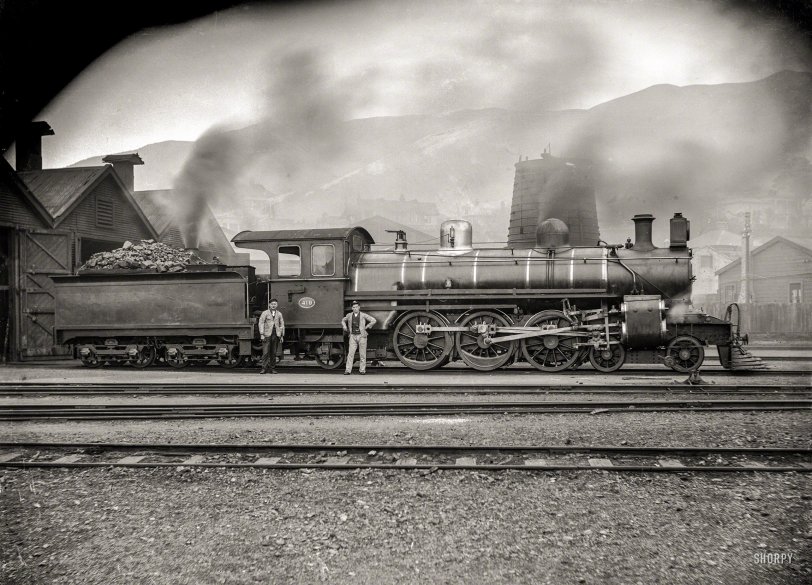


Framed or unframed, desk size to sofa size, printed by us in Arizona and Alabama since 2007. Explore now.
Shorpy is funded by you. Patreon contributors get an ad-free experience.
Learn more.

- Texas Flyer wanted
- Just a Year Too Soon
- WWII -- Replacing men with women at the railroad crossing.
- Yes, Icing
- You kids drive me nuts!
- NOT An Easy Job
- I wonder
- Just add window boxes
- Icing Platform?
- Indiana Harbor Belt abides
- Freezing haze
- Corrections (for those who care)
- C&NW at Nelson
- Fallen Flags
- A dangerous job made worse
- Water Stop
- Passenger trains have right of way over freights?
- Coal
- Never ceases to amaze me.
- Still chuggin' (in model form)
- Great shot
- Westerly Breeze
- For the men, a trapeze
- Tickled
- Sense of loneliness ...
- 2 cents
- Charm City
- What an Outrage
- Brighton Park
- Catenary Supports
Print Emporium
Class A: 1909

New Zealand circa 1909. "Class A locomotive, NZR No. 419, at the Petone Railway Workshops." A.P. Godber Collection, Alexander Turnbull Library. View full size.
Re: Counterweight
I have learned much from Shorpy by looking up interesting items. The driver diameter question got me started on this Locomotive. Apparently this series was originally built as a compound arrangement with four cylinders. The two unseen cylinders were under the smoke box and attached to a cranked axle on the front wheels. The total rotational balance of all that equipment on the front axle determined the odd weight placement. As with almost all locomotives of this design the inner cylinders and related equipment were a maintenance nightmare, eventually having the center cylinders and equipment removed.
De Glehn compound
The A's were built as De Glehn compounds with 4 cylinders. The two hp cylinders were between the frames driving the leading coupled wheels via a crank axle. That's why the balance weight is located near the crankpin.
As for the big lumps of coal, an good fireman would use his coal pick to break them up if needed. But in my experience an engine like this will steam much better when fired with larger sized coal such as we see on 419. Put in a good bank under the door and in the back corners and they'll steam like a witch. (I've fired an NZR Ab a couple of times, and footplated A 428 at Weka Pass.)
As for mechanical stokers on steam locos, they were in use before 1909. The Pennsy were using Crawford stokers from 1905 onwards.
At any rate, it's a lovely photo of a beautiful engine and her crew.
Find Waldo
Are there 3 locomotives in this picture?
Counterweights
It's curious that the counterweight on the lead driver is on the same side as the coupling rod.
No. 419
No. 419 had a long life, being built in 1908 and retired in July 1961.
Aching Back
Some boulder-sized coal in that tender. And mechanical stokers yet to be invented. I would not want to be that fireman.
Narrow Gauge
NZR is 3' 6" gauge (as opposed to 4' 8-1/2" US standard gauge), hence the relatively small driving wheels.
Drive, he said
Those are remarkably short drivers for a Pacific, which was an extremely popular passenger engine type. Looking at the relative height of the wheels and the crewman, I don't think they can be much more than 60-inch drivers. Passenger engine drive wheels ran from 68 to as much as 80 inches.
Wonderful.
What a beautiful early Pacific Locomotive. I have a little one in brass.
























On Shorpy:
Today’s Top 5